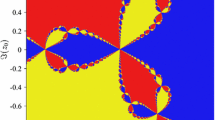Abstract
With the concepts of fractals, introduced by B. B. Mandelbrot in the 1970s, geometry assumes again, after Poincaré, a leading role in the theory of dynamical systems and chaos. Dynamical instability and unpredictability in time become inseparable from geometrical complexity and irregularity in space, through self-similarity under scaling. Chaos theory thus acquires its natural setting and description in terms of fractal geometry and symbolic dynamics. Objects of non-integer dimension and distributions with spectra of generalized dimensions become familiar concepts of aesthetic, even philosophical value, while giving researchers at the same time new tools to probe deeper into complex natural phenomena. In this paper, I review in a pedagogical way the main ideas of fractal geometry, multifractal distributions and symbolic dynamics. Of central importance is the connection between temporal and spatial complexity, while important applications of the formalism are also mentioned, particularly in the area of chaotic time series analysis.
Similar content being viewed by others
Bibliography
D. Arrowsmith, C. N. Place, Introduction to Dynamical Systems, Cambridge University Press, Cambridge, 1990.
M. Barnsley, Fractals Everywhere, Academic Press, Boston, 1988.
A. Bezerianos, T. Bountis, G. Papaioannou, and P. Polydoropoulos, Chaos 5(1), 95 (1995).
T. Bountis, L. Karakatsanis, G. Papaioannou, and G. Pavlos, Ann. Geophys. 11, 947 (1993).
T. Bountis, Fundamental Concepts of Classical Chaos, Part I, Information Dyn. Open Sys. 3, 23 (1995).
G. Casati and B. Chirikov, Quantum Chaos, Oxford University Press, Oxford, 1995.
K. J. Falconer, Geometry of Fractal Sets, Cambridge University Press, Cambridge, 1985.
A. M. Fraser and H. L. Swinney, Phys. Rev. A 33, 1134 (1986).
P. Grassberger, J. Stat. Phys. 19, 25 (1981).
P. Grassberger and I. Procaccia, Phys. Rev. Lett. 50, 346 (1985).
J. Guckenheimer and P. J. Holmes, Nonlinear Oscillations, Dynamical Systems and Vector Fields, Springer, New York, 1983.
H. G. E. Hentchel and I. Procaccia, Physica 8 D, 435 (1983).
J. Hutchinson, Indiana Univ. J. Math. 30, 713 (1981).
A. Karytinos and G. Papaioannou, Int. J. Bifurc. Chaos 5(6), 1557 (1995).
B. B. Mandelbrot, The Fractal Geometry of Nature, also, 1982, Fractals: Form, Chance and Dimension, Freeman, New York.
J. Moser, Stable and Random Motions, Princeton University Press, Princeton, 1973.
J. S. Nicolis, Dynamics of Hierarchical Systems: An Evolutionary Approach, Springer-Verlag, Berlin, 1986.
G. Nicolis and I. Prigogine, Exploring Complexity, Freeman, New York, 1989.
G. Pavlos, L. Karakatsanis, J. Latoussakis, D. Dialetis, and G. Papaioannou, Int. J. Bifurc. Chaos 4(1), 87 (1993).
H.-O. Peitgen, H. Jurgens, and D. Saupe, Fractals for the Classroom, vol. 1, Springer, New York, 1992.
S. N. Rasband, Chaotic Dynamics of Nonlinear Systems, Wiley-Interscience, New York, 1990.
A. Renyi, Probability Theory, North Holland, Amsterdam, 1970.
M. Schroeder, Fractals, Chaos and Power Laws, Freeman, New York, 1991.
H.-G. Schuster, Deterministic Chaos, 2nd ed., VCH, Weinheim, 1988.
S. Smale, Differentiable Dynamical Systems, Bull. Amer. Math. Soc. 73, 747 (1967).
F. Takens, Lecture Notes in Math. 898. Springer, Berlin, p. 366, 1981.
S. Wiggins, Introduction to Applied Dynamical Systems and Chaos, Springer, New York, 1990.
Author information
Authors and Affiliations
Rights and permissions
About this article
Cite this article
Bountis, T. Fundamental Concepts of Classical Chaos. Part II: Fractals and Chaotic Dynamics. Open Systems & Information Dynamics 4, 281–322 (1997). https://doi.org/10.1023/A:1009690504708
Issue Date:
DOI: https://doi.org/10.1023/A:1009690504708




